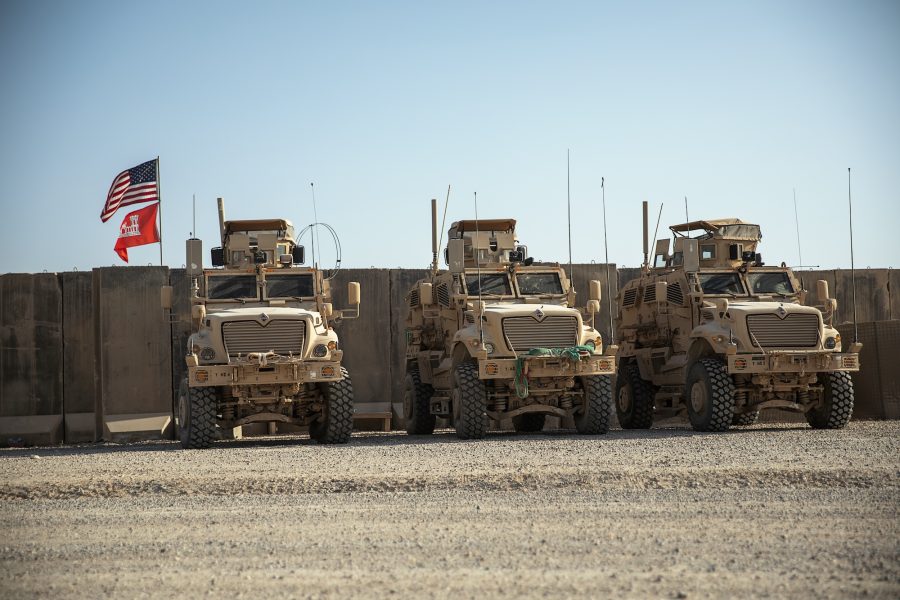A rocket attack on an air base in Iraq injured several U.S. personnel on Aug. 5, U.S. officials said.
The episode at Al Asad Air Base occurred amid an uptick in strikes against U.S. forces in Iraq and Syria in recent weeks by Iranian-aligned militias and as the U.S. is moving aircraft and ships to the region to help defend Israel against an expected Iranian attack.
Five U.S. service members and two U.S. contractors were injured when two rockets impacted the base around 2 p.m. local time, a U.S. defense official told Air & Space Forces Magazine. All seven Americans are in stable condition, the official said, though two “have been evacuated for further care,” with the rest receiving care on base. “Post-strike assessments are still ongoing,” the official added.
The Pentagon attributed the attack to an Iranian-aligned militia.
Tensions in the Middle East have been running high following the July 30 killing of the political leader of Hamas, Ismail Haniyeh, believed to have been conducted by Israel. The same day, the U.S. carried out its first airstrike in months in Iraq to thwart a drone attack by an Iranian-backed militia.
The U.S. has said the two events were unrelated and it had no knowledge of the operation that killed Haniyeh. Still, U.S. officials say they have been bracing for an increase in attacks by Iranian-aligned militias against U.S. troops—and have said they are prepared to respond with force to protect Americans.
President Joe Biden and Vice President Kamala Harris were briefed on the attack on Al Asad during a meeting with their national security team, including Secretary of Defense Lloyd J. Austin III, on the Middle East that “focused on the threats posed by Iran and its proxies to Israel and to U.S. service members in the region,” the White House said.
“They discussed the steps we are taking to defend our forces and respond to any attack against our personnel in a manner and place of our choosing,” the White House added.
Austin spoke with Israeli Minister of Defense Yoav Gallant and discussed threats from Iran, Lebanese Hezbollah, and Iranian-aligned militias on Aug. 5, the Pentagon said.
“Secretary Austin and Minister Gallant agreed that today’s Iran-aligned militia attack on U.S. forces stationed at Al Asad Air Base in western Iraq marked a dangerous escalation and demonstrated Iran’s destabilizing role in the region,” Pentagon Press Secretary Patrick S. Ryder said in a readout of the call.
The Pentagon says there have been over 180 attacks by Iranian-backed militias on U.S. troops in Iraq, Jordan, and Israel since Hamas’s Oct. 7 attack on Israel in October sparked region-wide violence. Three Soldiers were killed in a January attack on Tower 22 in Jordan, which supports the Al Tanf U.S. outpost in eastern Syria.
There are an estimated 2,500 U.S. troops in Iraq and 900 in Syria supporting the fight against the Islamic State group, as well as 4,000 American service members throughout Jordan.
The U.S. launched a major retaliatory strike in early February with fighters and B-1 bombers against 85 targets in Iraq and Syria affiliated with Iran’s Islamic Revolutionary Guard Corps and Iranian-aligned militias. This airstrikes largely accomplished the Pentagon’s goal to stoping the attacks on U.S. and led to a provide of relative calm with only sporadic incident. Now U.S. officials are expecting those attacks to likely increase.
Two rockets were fired at Al Asad Air Base in Iraq on July 25, U.S. defense officials previously told Air & Space Forces Magazine.
The Aug. 5 attack appeared to be carried out by two 122mm rockets fired from a truck launcher, according to the Washington Institute for Near East Policy’s Militia Spotlight.
The U.S. is deploying F-22 fighters and warships and may be increasing land-based air defenses as it prepares for a possible Iranian attack on Israel and potential region-wide escalation by Iran’s network for proxy groups.
Biden and Harris were briefed on “U.S. military efforts to support the defense of Israel should it be attacked again” and “continued diplomatic efforts to de-escalate regional tension and to bring the ceasefire and hostage release deal [between Hamas and Israel] to a conclusion,” the White House said.
Iran attacked Israel on April 13 with roughly 300 missiles, rockets, and drones. Israel shot down many of the projectiles, while U.S. F-15Es and F-16s also shot down more than 80 Iranian drones and U.S. warships intercepted multiple ballistic missiles. A U.S. Patriot surface-to-air system in Erbil, Iraq, also took down a missile.
Al Asad is equipped with an advanced Patriot battery and other air defense systems but has repeatedly come under attack in strikes that injured Americans.
“Of course, we’re postured to always protect our forces in the region,” Deputy Pentagon Press Secretary Sabrina Singh told reporters on Aug. 5.
Editor’s Note: This article was updated on Aug. 6 with additional details.


